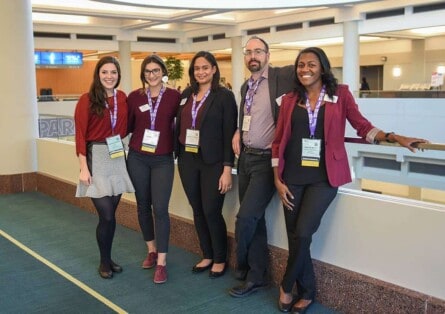In the early 1970s, Yvonne Brill, F. SWE, put in a lot of hours in the office and at home after her children were in bed, inventing an electrothermal hydrazine thruster that continues to propel geosynchronous communications satellites into space today. This invention ultimately garnered Brill, the National Medal of Technology and Innovation, and a seat in the National Inventors Hall of Fame. She was an anomaly, both at work and in the neighborhood.
“At some company party somebody asked my husband — there were not very many wives out working then, either, in the late ‘60s and early ‘70s — they asked Bill how did he feel about the long hours I put in,” she recalled in a 2006 Profiles of SWE Pioneers Oral History Project interview. She continued with a laugh, “He said, well, he’d be happy to outlive me and spend all the money that I made.”
Women engineers were exceedingly rare, comprising less than one tenth of one percent of all engineers in the United States when the Society was founded in 1950. In that scarcity bred contempt from men who believed women were not technically capable, who thought women should tend to home and family rather than career, who worried that women would take their jobs. SWE’s archives are full of oral history interviews, speeches, and newspaper clippings detailing unsavory anecdotes about male colleagues, bosses, and sometimes even male relatives who underestimated or belittled women in engineering.
But there are also stories about the male allies who made space for women in engineering and provided them with opportunities. Anne Perusek, director of editorial and publications for SWE, and Troy Eller English, SWE’s archivist, shared a few of those stories in a recent SWE podcast episode, “SWE Stories – Tales from the Archives: Male Allies and Generational Change.”
Among the stories shared were audio clips from oral history interviews with George Brewster and Walter McFall, both recipients of the Society’s Rodney D. Chipp Memorial Award. An award givenannually to a man or company who has contributed significantly to the acceptance and advancement of women in engineering. As explained in the Scrapbook article published in the Conference 2021 issue of SWE Magazine titled, “The Men Who Took Us Seriously”, the award is named after the husband of SWE’s first president, who took the professional aspirations of SWE’s early members seriously when many of his male peers did not.
For a more recent perspective, also found in the Conference 2021 issue, magazine contributor Sandra Guy interviewed experts and an engineering manager and Chipp Award recipient for the article, “Male Allies Must Focus on the Details to Help Women Succeed”. The interviewees found that workplace gender inequities migrated to virtual environments during the COVID-19 pandemic, stifling individual productivity and organizational success as the virtual environment provided men even more opportunity to speak over their female colleagues during meetings, or have private side conversations in chat windows. Those interviewed also outlined specific ways male allies can counter these and other inequities in the workplace.
Among those interviewed for the article was Brad Johnson, Ph.D., a professor of psychology at the United States Naval Academy and a faculty associate in the Graduate School of Education at Johns Hopkins University. He will be speaking October 22, 2021 at a WE21 Inspirational Insight session titled “Leveraging Male Allies to Champion Gender Inclusion and Equity.” Dr. Johnson will share with both in-person and virtual conference attendees how men can be more effective allies, how women can leverage the allyship of their male colleagues, and how gender equality and cross-gender collaboration benefits all.
From the days that women were less than 1% of working engineers until now, when they make up roughly 14% of the engineering workforce, there have been supportive men who seemed a bit ahead of their time. In today’s language, we would call them male allies. Dr. Johnson’s advocacy exemplifies how being a male ally has evolved from offering support for individual women to actively promoting policies that influence social attitudes and workplace cultures to the benefit of all.
Author
-

SWE Blog provides up-to-date information and news about the Society and how our members are making a difference every day. You’ll find stories about SWE members, engineering, technology, and other STEM-related topics.






